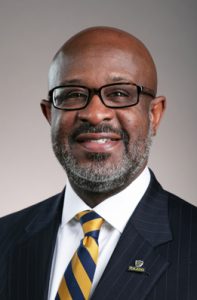
By Willie McKether, PhD
Guest Column
It has been the honor of my career to create the Office of Diversity and Inclusion at The University of Toledo.
Many dedicated individuals have created over the years programs and initiatives to increase diversity, support underrepresented minority students, faculty and staff, and promote equity on our campuses. As I have said many times, this type of work is everyone’s responsibility. In 2016 then-president Dr. Sharon Gaber created the Vice President for Diversity and Inclusion position to have a person on the senior leadership team responsible for efforts to ensure every member of the UToledo community feels included, respected and free from discrimination.
While we have not accomplished everything I sought to do during the past five years, I am proud of the progress we have made to support students, employees and the greater Toledo community. There has always been great support for the value of our efforts and I am thankful to everyone who contributed to our successes.
Our inaugural strategic diversity plan guided our efforts for the first three years, from 2016 through 2019. It took eight months to build with extensive input from students, faculty, staff and members of the community.
There were important advances supported by that plan. Top among them, for me, is improved success of our underrepresented minority students. As we looked at the data to put together our updated second diversity strategic plan to guide our efforts from 2020 to 2023, we tracked positive progress in our 6-year graduation rates and first-to-second year retention rates.
In the five-year period from 2015 to 2019 the graduation rates and retention rates improved for all students. For Black or African American students it improved eight percentage points and increased four percentage points for Hispanic or Latino students. During that same time period the retention rate improved 21.2 percent for Black or African American Students and 7.3 percent for Hispanic or Latino students.
Key positions have been added in Enrollment Management and the Provost’s Office focused on the recruitment and retention of underrepresented minority students to continue to advance these efforts, which remains a top goal in our second diversity strategic plan. Our current plan also set goals to increase the recruitment and retention of underrepresented faculty and staff, cultivate community partnerships and increase supplier diversity.
During the implementation of the first diversity strategic plan we also were successful in increasing the diversity of our faculty, including a 37 percent increase in Black or African American faculty from 2015 to 2019 and a 20 percent increase in faculty members who identify as Asian. During that same period we experienced increases in staff diversity of individuals who identify as Asian (16%), Hispanic or Latino (9.8%) and Black or African American (1.4%). The number of staff members who identify as American Indian or Alaska Native doubled and we experienced a 48 percent increase in individuals who identify as two or more races.
In addition to the Office of Diversity and Inclusion expanding to include an office on the Health Science Campus and adding personnel, I’m proud to report that there are diversity plans, committees and leaders established in all of our degree-granting academic colleges.
We’ve also created a number of scholarships to support underrepresented minority students named for past University leaders, such as Lance Thompson and Tony Quinn, from which future generations of Rockets will benefit.
During the COVID-19 pandemic and the national movement to address systemic racism fueled by racial injustice and police brutality following the killing of George Floyd, we held 15 Dialogue on Diversity virtual town hall events discussing topics from microaggressions to vaccines to anti-Asian hate. Each of those events was well attended despite so many of us getting video conference fatigue. This was an event that our campus community wanted to sit in front of their screens for and I appreciated the honest and collaborative discussions on a wide variety of important topics. It was a great expansion of a program that was held less frequently in the years before.
Most recently one of the key initiatives identified by President Gregory Postel early in his tenure at the University was identifying and addressing systemic racism on our campuses. To be clear, it is not an effort to address a known issue at UToledo but an understanding that over time and in every industry across our country there is the potential for racial bias to have impacted policies and procedures. I was proud to lead that team and look forward to following what it accomplishes moving forward.
My professional background and training is in cultural anthropology and I have always had a personal interest in multicultural retention efforts. Years before I moved into this administrative role I helped to establish the Brothers on the Rise mentoring program for African American and Latino male students and the Multicultural Emerging Scholars Program, which is a six-week summer bridge program for incoming students of color can get a head start before the start of the academic year. This past year, I am proud to have led the creation of the Inclusive Wall of Honor as well as the Center for Racial Equity and Black Student Excellence, which includes the Dr. Donald Baker Student Resource Room.
I could not be more proud to have applied my expertise and passions to create UToledo’s Office of Diversity and Inclusion. The team will have strong leadership in Dr. Charlene Gilbert during the transition and I know UToledo is committed to finding the best permanent leader to take what we started and move it forward. Thank you for the honor of leading this important work.
Dr. Willie McKether, vice president of diversity and inclusion and vice provost, is completing his tenure at The University of Toledo. He has been appointed chancellor for Thomas Jefferson University’s East Falls Campus in Philadelphia.
